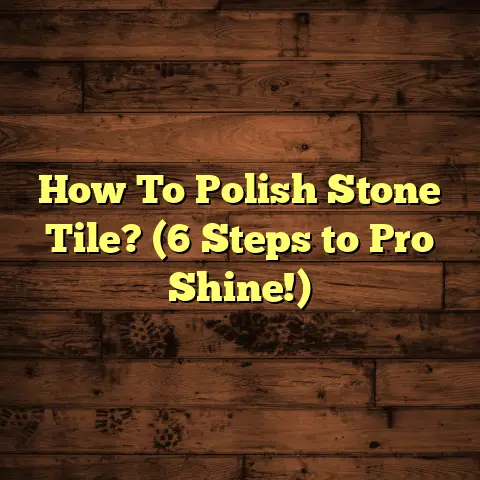Shine Wood Floors: No Sanding Needed! (4 Secrets)
Ever dream of walking into a room and being greeted by floors so radiant, they practically sing? You know, the kind that make you feel like you’re living in a magazine spread?
Well, I’m here to tell you that achieving that showroom shine on your wood floors doesn’t always mean enduring the dust storm of sanding and refinishing.
As a flooring contractor with years of experience under my belt, I’ve learned a few tricks of the trade that can help you achieve that gorgeous luster without the hassle.
So, grab a cup of coffee, and let’s dive into four secrets to shine your wood floors without ever picking up a sander!
Section 1: Understanding Wood Floor Finishes
Before we jump into the secrets, it’s crucial to understand what we’re working with. Think of your wood floor finish as its protective armor, but also the key to its beauty.
Subsection 1.1: Different Types of Wood Floor Finishes
You might be surprised to learn how many different types of wood floor finishes exist. Each offers a unique blend of protection, appearance, and maintenance requirements.
Here’s a quick rundown of some common types:
-
Oil-Based Polyurethane: This is the classic workhorse. It’s durable, provides a warm amber tone, and offers excellent protection against scratches and water damage.
However, it can yellow over time and has a strong odor during application. * Water-Based Polyurethane: A more modern option, water-based finishes are low in VOCs (volatile organic compounds), making them a more environmentally friendly choice.
They dry quickly and offer a clear finish that won’t yellow. However, they might not be as durable as oil-based options. * Acrylic Finishes: Acrylic finishes are known for their flexibility and resistance to cracking. They are often used in high-traffic areas and are available in various sheens, from matte to glossy. * Penetrating Oil Finishes (like Tung Oil): These finishes soak into the wood, enhancing its natural beauty and providing a low-luster, matte finish.
They require more frequent maintenance but are easy to repair. * Wax Finishes: Wax provides a beautiful, natural sheen but offers minimal protection against scratches and water damage.
They are best suited for low-traffic areas and require regular waxing.
The finish you have on your floor plays a huge role in how you should care for it. For instance, using the wrong cleaner on a waxed floor could strip the finish, leaving it dull and unprotected.
Subsection 1.2: Importance of Regular Maintenance
Think of your wood floors like your skin. If you neglect them, they’ll start to show it. Regular maintenance is the key to keeping them looking their best and extending their lifespan.
Why is regular maintenance so crucial?
- Prevents Scratches and Dents: Daily sweeping and vacuuming remove dirt and grit that can scratch the finish.
- Protects Against Water Damage: Quickly wiping up spills prevents water from seeping into the wood and causing damage.
- Maintains the Finish: Regular cleaning and conditioning help maintain the finish’s integrity, preventing it from becoming dull and worn.
- Extends the Lifespan: By taking care of your floors, you can avoid the need for costly sanding and refinishing down the road.
Common Misconceptions About Wood Floor Care:
- “I don’t need to clean them often because they don’t look dirty.” Dust and dirt are abrasive and can scratch the finish even if you don’t see them.
- “Any cleaner will do.” Harsh chemicals can damage the finish and dull the shine.
- “Sanding is the only way to restore shine.” With the right care, you can maintain the shine without sanding.
Section 2: Secret #1 – The Power of Cleaning
Cleaning is the foundation of any good wood floor care routine. It’s like brushing your teeth – you wouldn’t skip it, right?
Subsection 2.1: Daily Cleaning Routines
A daily cleaning routine doesn’t have to be time-consuming. A few simple steps can make a huge difference.
-
Sweep or Vacuum Daily: Use a soft-bristled broom or a vacuum with a floor brush attachment to remove dust, dirt, and debris.
Pay special attention to high-traffic areas and entryways. * Use a Microfiber Dust Mop: Microfiber mops are excellent for picking up fine dust and dirt that a broom or vacuum might miss.
Pro Tip: Place mats at doorways to trap dirt and prevent it from being tracked onto your wood floors.
Subsection 2.2: Choosing the Right Cleaning Products
Not all cleaning products are created equal. In fact, using the wrong cleaner can do more harm than good.
-
Wood-Safe Cleaners: Look for cleaners specifically designed for wood floors.
These cleaners are pH-neutral and won’t damage the finish. Brands like Bona and Armstrong offer excellent options. * Avoid Harsh Chemicals: Steer clear of cleaners containing ammonia, bleach, or abrasive ingredients. These can strip the finish and dull the shine. * DIY Cleaning Solutions: If you prefer a more natural approach, you can make your own cleaning solution using simple ingredients.
Here’s a recipe I often recommend:
- 1/4 cup white vinegar
- 1 gallon of warm water
Mix the ingredients in a bucket and use a damp (not wet!) mop to clean the floors. Be sure to wring out the mop thoroughly to avoid excess water.
Important Note: Always test any cleaning solution in an inconspicuous area before applying it to the entire floor.
Section 3: Secret #2 – The Magic of Conditioning
Think of wood conditioning as moisturizing your skin. It replenishes the natural oils in the wood, keeping it supple and preventing it from drying out and cracking.
Subsection 3.1: What is Wood Conditioning?
Wood conditioners are specially formulated products that penetrate the wood’s surface, nourishing and protecting it.
Benefits of Wood Conditioning:
- Restores Shine: Conditioners help restore the natural luster of the wood, making it look brighter and more vibrant.
- Protects Against Drying and Cracking: By replenishing the wood’s natural oils, conditioners prevent it from drying out and cracking.
- Enhances the Finish: Conditioners can help enhance the finish’s durability and resistance to scratches and water damage.
Subsection 3.2: How to Apply Conditioner Correctly
Applying wood conditioner is a simple process, but it’s important to do it correctly to avoid damaging the finish.
Step-by-Step Guide:
- Clean the Floors: Start by thoroughly cleaning the floors to remove any dirt, dust, or debris.
- Apply the Conditioner: Pour a small amount of conditioner onto a clean microfiber cloth.
- Work in Sections: Apply the conditioner to the floor in small sections, working with the grain of the wood.
- Buff the Floor: Use a clean, dry microfiber cloth to buff the floor, removing any excess conditioner.
- Allow to Dry: Allow the conditioner to dry completely before walking on the floor.
Best Practices:
- Choose the Right Conditioner: Select a conditioner that is specifically designed for your type of wood floor finish.
- Apply Sparingly: A little conditioner goes a long way. Avoid applying too much, as this can leave the floor feeling sticky.
- Follow the Manufacturer’s Instructions: Always read and follow the manufacturer’s instructions for application and drying times.
- Condition Regularly: Condition your wood floors every 3-6 months, or as needed, to maintain their shine and protect them from damage.
Section 4: Secret #3 – Utilizing the Right Tools
Having the right tools can make all the difference in your wood floor care routine. It’s like having the right ingredients for a recipe – you can’t make a delicious dish without them!
Subsection 4.1: Essential Tools for Shine
Here’s a list of essential tools for maintaining the shine of your wood floors:
- Soft-Bristled Broom: For daily sweeping to remove dust and debris.
- Vacuum with Floor Brush Attachment: For removing dirt and grit without scratching the finish.
- Microfiber Dust Mop: For picking up fine dust and dirt.
- Microfiber Mop: For applying cleaning solutions and conditioners.
- Buckets: For holding cleaning solutions and rinse water.
- Microfiber Cloths: For wiping up spills, applying conditioners, and buffing the floor.
- Floor Buffer: For enhancing shine and removing scuff marks (we’ll talk more about this in the next section).
Subsection 4.2: The Importance of Quality Equipment
Investing in quality equipment can save you time, effort, and money in the long run.
- Durable Tools: High-quality tools are built to last, so you won’t have to replace them as often.
- Effective Cleaning: Quality mops and cloths are more effective at picking up dirt and grime, leaving your floors cleaner and shinier.
- Gentle on Floors: Soft-bristled brooms and microfiber mops are gentle on the finish, preventing scratches and damage.
Pro Tip: When choosing a mop, look for one with a machine-washable microfiber pad. This will save you money and ensure that you’re always using a clean mop head.
Section 5: Secret #4 – The Art of Buffing
Buffing is like giving your wood floors a spa treatment. It polishes the surface, removing scuff marks and restoring shine.
Subsection 5.1: Understanding Buffing Techniques
Buffing involves using a floor buffer to polish the surface of the wood floor.
Benefits of Buffing:
- Enhances Shine: Buffing removes scuff marks and polishes the surface, making the floors look brighter and more vibrant.
- Removes Scuff Marks: Buffing can effectively remove minor scuff marks and scratches, restoring the floor’s appearance.
- Improves the Finish: Buffing can help improve the finish’s durability and resistance to scratches and water damage.
Subsection 5.2: How to Buff Your Floors Without Sanding
Buffing your floors without sanding is a gentle and effective way to restore their shine.
Step-by-Step Guide:
- Clean the Floors: Start by thoroughly cleaning the floors to remove any dirt, dust, or debris.
-
Choose the Right Pad: Select a buffing pad that is appropriate for your type of wood floor finish.
- For light buffing: Use a white or beige polishing pad.
- For removing scuff marks: Use a more abrasive pad, such as a maroon or green scrubbing pad.
- Apply Buffing Compound (Optional): If you want to enhance the shine, you can apply a small amount of buffing compound to the floor. Be sure to use a compound that is specifically designed for wood floors.
- Buff the Floor: Use the floor buffer to buff the floor in overlapping strokes. Start in one corner of the room and work your way across, moving slowly and steadily.
- Remove Residue: Use a clean microfiber cloth to remove any residue from the buffing compound.
Equipment:
- Floor Buffer: You can rent a floor buffer from most home improvement stores.
- Buffing Pads: Choose the right buffing pad for your type of wood floor finish.
- Buffing Compound (Optional): Use a buffing compound that is specifically designed for wood floors.
Important Notes:
- Practice First: Before buffing your entire floor, practice in an inconspicuous area to get a feel for the buffer and the buffing pad.
- Don’t Over-Buff: Over-buffing can damage the finish, so be careful not to spend too much time in one area.
- Wear Safety Gear: Wear safety glasses and a dust mask to protect yourself from debris and dust.
Section 6: Conclusion
So, there you have it – four secrets to shining your wood floors without ever having to sand them!
Recap of the Four Secrets
Let’s quickly recap the secrets we’ve discussed:
- The Power of Cleaning: Regular cleaning is the foundation of any good wood floor care routine.
- The Magic of Conditioning: Conditioning replenishes the wood’s natural oils, keeping it supple and preventing it from drying out.
- Utilizing the Right Tools: Having the right tools can make all the difference in your wood floor care routine.
- The Art of Buffing: Buffing polishes the surface, removing scuff marks and restoring shine.
Encouragement for Readers
I know that taking care of wood floors can seem daunting, but it doesn’t have to be. By following these simple tips, you can keep your floors looking their best for years to come.
So, go ahead, give these secrets a try. I promise you’ll be amazed at the results. And remember, a little bit of effort can go a long way in maintaining the beauty and value of your wood floors. Happy shining!





